A pair of two miniature Dutch clogs.
It was a gentle reminder that I needed to take baby steps to finish my PhD.
At the time, I was touched by the gift (the clogs looked so sweet). But I also remember feeling kind of frustrated. I found myself thinking, “Ugh. Baby steps!”
I hated the idea of baby steps.
“Baby steps are for babies!”, I thought.
But I was wrong.
The baby step is your secret psychological weapon for getting stuff done.
Once you master the art of the baby step, life becomes a lot less stressful. Feelings of overwhelm disappear. But I have to admit, it took me a few years to realise the power of the baby step.
In his brilliant book How we change (and ten reasons why we don’t) Dr Ross Ellenhorn states:
“. . . small steps remind us of the distance to our goals and the disparity between what we want to be and what we currently are.”
Those little Dutch clogs were a painful reminder of how far I still had to go to complete my doctorate. Naturally, this brought up some feelings of discomfort, frustration and disappointment. I found myself thinking:
“I’ve been doing this for 5 years and I’m still not there yet! It’s taking forever! What’s wrong with me?”
We live in a world of instant gratification. There’s this cultural belief that everything should be fun, fast and easy.
When progress towards our goals doesn’t happen quickly, we can feel frustrated and demoralised.
But we need to remember, worthy endeavours take time and effort. If you want to achieve something meaningful and worthwhile in life, you’ll need to embrace baby steps.
In his book Tiny Habits Professor BJ Fogg provides some great advice on the importance of baby steps. He says:
“It’s time for someone to say it: you’ve got to lower your expectations. When I say this, people sometimes gasp. Or they smirk. Or they think I’m joking. But I’m serious.
Yes, in our hyperachieving, go-getter world, I’m telling you to lower the bar. Not because I don’t want you to achieve great things, but because I know you need to start small in order to achieve them. But you can’t succeed with starting small if you’re looking down your nose at it. Why do we clap for a baby when she is taking her first step? Not because she is doing it perfectly or because she “earned it” or because she did it bigger and better than the baby next door. We clap because we know it is the first small step that she is taking toward a lifetime of walking and running – and that is hugely important.”
You need to seriously lower the bar (and your expectations).
As writer and comedian Catherine Deveny says, “Plan to do less and you will do more”.
I recently realised my baby steps were way too big. They weren’t baby steps at all! They were more like giant leaps. No wonder I was having trouble getting started.
So I had to scale them right back.
The key to mastering the practice of baby steps is to make them really easy to do. Each step has to be so small and so easy that you can’t fail.
For example, instead of telling myself “Cook one pot burrito dish for dinner”, I now say “Place pot on stove” or “Turn on stove”.
These steps are less scary for my brain, so I’m more likely to get started.
I have a tendency to focus on everything I need to do all at once. I look at a project and it feels like this ugly mess . . .
I call this creature the Beast of Overwhelm. It feels like a big fat tangled mess of ideas. When this jumbled beast strikes, my mind screams “I don’t wanna!” and “It feels too hard!”. I want to run and hide. In those moments, the baby step is no where to be seen.
But the baby step is how you conquer this creature. The baby step is the only way to show this beast who is in charge. The baby step says, “Hey! Back off! Because I’m the one in control here!”.
Once you get clear on the little strand you’re going to untangle (i.e. the baby step) and you’re in action, that beast loses its power. The anxiety and overwhelm subside pretty quickly.

As Jen Sincero (author of You are a badass) explains:
“Overwhelm cannot touch you when you’re all wrapped up in the here and now. Overwhelm is a mindset. It’s the choice to focus on everything all at once and stress yourself out. Instead, choose to take your life moment by moment and savour it, like pulling bon-bons [chocolates] out of heart-shaped box and popping them into your mouth, one by one.”
If you’ve been feeling overwhelmed by a project, don’t despair. You just have to show the Beast of Overwhelm who’s the boss.
Ask yourself, “What’s my next baby step?” Make it so easy and small you can’t fail. Write it down and go do it. Don’t delay. Start untangling the beast today. You’ll feel better if you do.
Share This:
Procrastination feels heavy.
But what if we could turn combating procrastination into a fun game?
Lately, when I catch myself avoiding a task, I’ll play a little game to see if I can get myself to move in the right direction.
I’ve discovered that it’s best to approach any task with a curious and playful mindset. If you take yourself too seriously, all the joy and fun can get stripped from the process.
Often, when I play this game, I surprise myself because the strategy works! I’ll be off and running with a task I procrastinated on for days.
But sometimes a strategy won’t work. That’s okay. When this happens, I usually take a little break before trying another approach.
I don’t claim to be a grandmaster at playing the game of combating procrastination. But these days, I can catch myself when procrastinating, notice the warning signs, and get moving in the right direction.
In this blog, I share how you can combat procrastination in a fun and playful way to fulfil your intentions and accomplish your goals.
Are you ready to play?
Let’s begin!
If you want to play this game of combating procrastination, you first need to understand what procrastination is and the rules of the game.
I recommend you play this game on your own so you’re not competing against anyone else. There’s no first or second place, no runners-up, and no one wins a trophy.
You can play with others, but it’s a collaborative game where you cheer each other on and gently coach each other into action.
It’s also a game that never ends because the work never ends. You are constantly learning and growing.
In her book ‘Procrastination: What it is, why it’s a problem and what you can do about it’ Dr Fuschia Sirois defines procrastination as:
“ . . . a common self regulation problem involving the unnecessary and voluntary delay in the start or completion of important intended tasks despite the recognition that this delay may have negative consequences.”
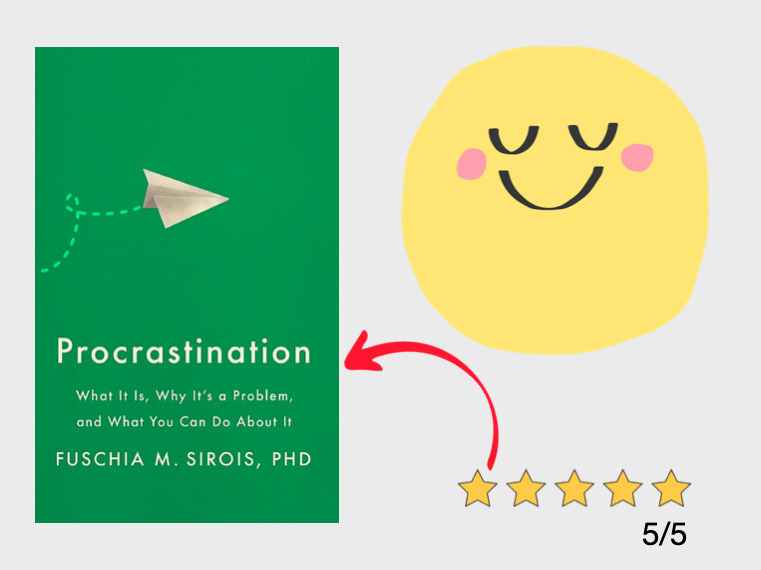
In other words, procrastination is:
Delaying a task + you know you are causing your Future Self pain and suffering.
There are some simple rules you need to understand to combat procrastination. Once you cement these rules in your brain, life becomes easier. Instead of experiencing constant resistance, you discover ease and flow.
Difficult work tends to bring up unpleasant emotions, such as boredom, stress, anxiety, fear, and frustration.
Most of us don’t like experiencing these feelings, so to repair our mood, we procrastinate. We avoid work and engage in easier, more fun tasks (e.g., scrolling through social media).
At the heart of combating procrastination is allowing yourself to sit with unpleasant feelings and push past them. Resist the urge to run to your devices. If you can do this, that’s 80% of the battle.
Pushing through the discomfort and making a start is a significant milestone worth celebrating.
Often, we wait for the perfect time to start a task. But it’s an illusion that there is a perfect time.
The perfect time is right now, amid the messiness and chaos of life.
“But I’m not feeling motivated!” I hear you say.
That’s okay. Make a start regardless of how you feel because here’s the part most people don’t understand:
Motivation follows action
In other words, you have to get moving for motivation to show up.
There are many great strategies and tools that can help you get started with a task, even when your motivation levels are low.
Once you have a selection of strategies and tools and you’ve practised using them a few times, you will feel more confident in your ability to combat procrastination.
Here are a few of my favourite strategies and tools for getting started with my work:
Fear is a significant driver of procrastination: fear that you won’t be able to do it, fear of failure, and fear of the unknown.
When you move your body, you decrease fear and anxiety. Movement can also help to calm and focus your mind and boost positive emotions.
This is why I start my day with a 20-30 minute run on my treadmill. It bathes my brain in feel-good chemicals, makes me feel stronger, and prepares me for the challenging work I’m about to face.
When a task feels big and overwhelming, it’s easy to procrastinate. But can you do 10 minutes on the task?
When I set a timer for 10 minutes, my brain thinks, “I can do 10 minutes. Easy!”
My brain then knows the task (and the unpleasant feelings) won’t last forever. The worst-case scenario is I experience 10 minutes of mild to moderate discomfort. When the timer goes off, I have a way out. I can do something else.
But what usually happens is after 10 minutes, I realise the task isn’t as bad as I thought it would be. The motivation has kicked in, and I’m on a roll.
When struggling to write my PhD, I attended a workshop led by an academic coach. She encouraged me to “Write crap” (her words, not mine).
This helped me to get over the perfection hump and make a start.
Most (if not all) great works started as rough drafts. The problem is we don’t see those rough early versions. We only see the polished final product. This messes with our minds and can lead to perfectionist tendencies kicking in.
Embrace the first messy draft. Celebrate it! You have to do it to get to the good stuff.
In the book ‘Everything in its Place’, Dan Charnas recommends the ‘Slow-but-don’t-stop’ technique for doing things you don’t want to do.
Here’s how it works:
If you’re feeling resistance towards a task, start doing it, but move very slowly. Breathe into the discomfort. Take your time.
Charnas writes that as you use this technique:
“You’ll still hate it [the task] but your task has become a moving meditation or like a game.”
For example, I used this strategy on the weekend to sort my laundry. The first step was to pick up the basket full of clothes and place it on my bed. Then, I picked up one item at a time and put them into piles (e.g., socks, activewear, and undies). I then selected a pile of items (socks) and dealt with one item at a time.
I’d usually rush to fold my clothes and feel slightly annoyed by the whole process (“Ugh, what a chore!”), but this time, it felt different. It felt like a meditation. I felt calm and grounded as I folded my socks.
The beauty of this technique is that the work will still get done, but as Charnas points out, you don’t give up control. You still have forward momentum.
As the Mexican proverb goes:
“An ant on the move does more than a dozing ox.”
Are there things in your workspace that distract you? Is there anything that reminds you of more fun stuff you could be doing (e.g., a video game console or your phone)?
Please get rid of those things or make them harder to access.
My phone is my biggest distraction. This is why I keep it away from my body in another room whenever I need to do focused work.
I’m currently experimenting with Mel Robbin’s 5-Second Rule. The 5-Second Rule is simple:
The moment you have the instinct to do a task before your brain can come up with an excuse not to do it, you count backwards ‘5 . . . 4 . . . 3 . . . 2 . . . 1!’ and you do it.
In her book ‘The 5 Second Rule’ Robbins explains the psychology underpinning the strategy. She writes:
“The counting distracts you from your excuses and focuses your mind on moving in a new direction. When you physically move instead of stopping to think, your physiology changes and your mind falls in line . . . the Rule is (in the language of habit research) a “starting ritual” that activates the prefrontal cortex, helping to change your behavior.”
The ultimate way to combat procrastination is to create a habit or a ritual. You need something that signals to your brain it’s time to engage in a particular behaviour.
With habits, you don’t have to stop and think, “What do I need to do now?”. Habits are automatic. Your brain knows exactly what it needs to do, and you do it.
For example, I have a habit of running on my treadmill before I launch into my day. My brain knows that after I put on my gym clothes and shoes, I turn on my treadmill and hit the speed button to start my warm-up.
I carry these behaviours out even when I’m not in the mood to run. That’s the power of habits.
Then, I suggest you cut yourself some slack.
Forgive yourself for procrastinating, pick a strategy, and get moving.
Most of us don’t do this, though.
We bag ourselves out in an attempt to motivate ourselves. The problem is this rarely works.
Dr Sirois says that intense self-criticism leads to negative thoughts, which lead to negative feelings. We end up feeling demotivated, which causes us to procrastinate even more!
You can stop the vicious cycle of procrastination by practising being kind to yourself.
If you follow these simple rules and be playful with experimenting with these strategies, you can get a better handle on procrastination.
Like anything in life, the key is practice. The more you practice allowing yourself to feel the unpleasant emotions instead of running from them, the better you’ll do. The more times you practice a strategy, the more natural it will feel and the sooner it will become a habit.
One foot in front of the other. You can do this.

This means you need to prepare yourself mentally and physically for them.
You can work so hard to memorise large quantities of information for an exam, but if you’re not mentally and physically prepared, all that hard work can sadly go to waste.
When it comes time to take your exams, you have to relate to yourself as a professional athlete. Leading up to the day of the big performance (i.e. the exam), you need to eat nutritious food, be in the right frame of mind, manage your nerves, and allow your body to rest. These simple things can make all the difference to your exam performance.
You may be thinking “But isn’t this just common sense?”
It is! But creating healthy habits takes time and practice.
It’s one thing to intellectually know you should be eating well but it’s another thing altogether to incorporate healthy meals and snacks into your lifestyle.
I see a lot of students drinking energy drinks, getting very little sleep, and eating highly processed foods in the days leading up to exams. I have to admit, there was a time when I engaged in these behaviours too. I can tell you from personal experience, this is a recipe for mediocre grades and a miserable existence.
Here are my top 10 tips to prevent burnout and boost exam performance:
Sleep is critical to the learning process, exam performance, and wellbeing. Yet it’s usually the first thing students sacrifice to get more study done.
If you miss two hours of sleep each night for a week, the cognitive effects are as bad as going without sleep for two days straight!
Studies have also found that if you stay awake for 18 hours straight that’s like having a blood alcohol level of 0.05. In other words, it’s like being legally drunk. Your ability to focus, think, and learn will be seriously impaired.
You can’t adapt to getting less sleep. As adolescents, you need about 9-10 hours of sleep per night to be as alert as possible when you wake up.
If that feels unachievable, try to just get an extra 15 minutes of sleep tonight. Gradually increase this each night until you reach your target.
Often students stop exercising when they start preparing for exams. They think “I don’t have time to exercise!”. It’s as if they think they must spend every moment studying. Don’t fall into this trap.
Movement is your friend when it comes to studying for exams.
Research shows engaging in regular physical movement will help you to study more effectively. Firstly, it’s a great way to relieve stress and release feel good chemicals. Secondly, it gets the blood flowing more efficiently to your brain, which can give you a cognitive boost.
One study found students who engaged in 5 minute movement breaks every 17 minutes during a lecture retained more information and could focus better.
Every time you engage in a short movement break, you’re enhancing your study sessions.
Research has found that students who skip breakfast experience a decrease in cognitive performance and alertness compared to students who eat breakfast.
Eating a nutritious breakfast will give you a cognitive boost before an exam. It will also help you to feel fuller for longer, stabilise your mood, and give you plenty of energy to get through the exam.
Here are some healthy breakfast ideas:
Muesli or porridge with nuts and fresh fruit (e.g., berries) Wholemeal toast with a variety of toppings (e.g., baked beans, tomatoes, and avocado) and a piece of fruit A healthy homemade smoothie (click here for my brain boosting smoothie recipe)
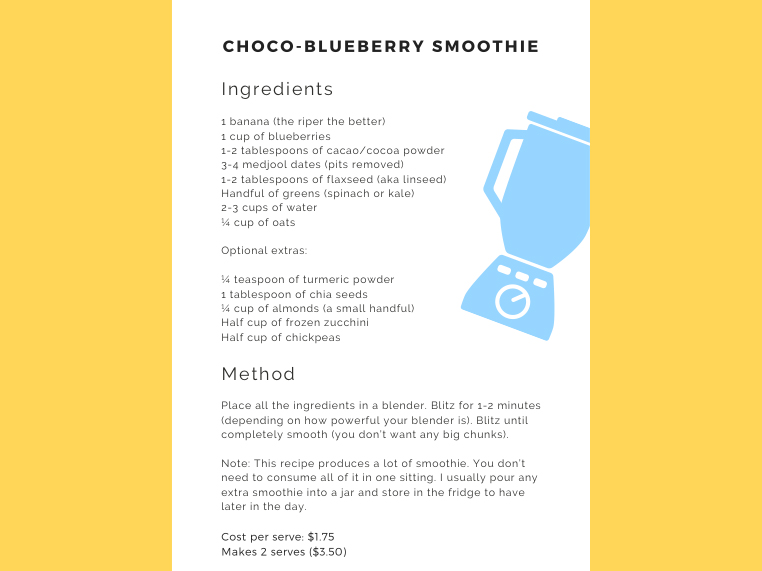
Your brain requires adequate hydration to function properly. Drinking water ensures that your brain receives the necessary fluids to perform tasks efficiently, such as retaining information and problem-solving.
Take regular sips of water as you study. It’s a good idea to have a glass of water or a reusable drink bottle within arms reach.
You may even want to create a tiny habit to remind yourself to engage in this simple behaviour (e.g., “After I finish answering a practice exam question, I will take a sip of water”).
Many years ago, I started thinking that my teachers and lecturers were out to get me. I thought they would mark me down wherever they got the chance. As a result of this distorted thinking, I became too scared to write anything in one of my first tests at law school. After receiving a terrible grade (5%), my brother said to me:
“Remember sis, your teachers want you to do well. They will try to give you marks wherever they can. It’s in their best interest to do so.”
Don’t worry about writing a perfect answer. If you’re unsure, be brave and still write something down. Even if it’s just a few dot points, it’s better than nothing. You may not get any marks for it, but your teachers won’t take marks off.
Just remember, most of the time your teachers are on your side and they want you to succeed. When you do well, it makes them look good.
Chances are there will always be something that you could have studied more thoroughly come the day of your exam. But on the morning of an exam, you can’t do much about that, so there’s no point worrying. Worrying will just deplete your finite energy, which you need to conserve for the exam.
Instead of worrying, try saying this to yourself before each exam:
“I now know so much more than I did before. I’ll be able to answer many questions in this exam.”
Telling yourself this positive micro-thought will allow you to enter the exam in a calm and confident frame of mind.
It’s normal to feel a bit nervous before an exam. But there are certain things and people that can push your anxiety levels into dangerous territory and impair your exam performance.
For example, coffee and energy drinks will skyrocket your stress levels. Similarly, hanging out with people who have a lot of nervous energy and are venting about the exam (“I’m going to fail!” and “I hardly studied!”) are going to leave you feeling distracted and a little jangled.
Before the exam, do your best to isolate yourself from these people. If you’re worried about offending someone who is venting to you, you could say “I’m sorry but I really need to do some last minute cramming”. Then proceed to pull out your notes and pretend to read them.
How many times have you stayed back after an exam to talk to your friends about what you put for each question? Have you ever felt terrible after doing this?
It can be reassuring to know that you wrote the same answer as your friends. But if you find out that you wrote something completely different, you may start to second guess yourself. If you have another four or five exams to go, this may throw you off your game.
This is why I don’t recommend engaging in a postmortem of the exam until you get your results/exam paper back.
When you walk out of the exam room, tell yourself:
“That exam is over. There’s nothing I can do to change how I went. It’s time to move on!”.
You could imagine yourself locking the exam in a box and throwing it off a cliff or rolling it up and stuffing it in a bottle and throwing it out to sea. The point is you need to mentally disconnect from that exam and focus on studying for the next one.

If you come across a question that you’re not sure how to answer, stop for a moment and take a few deep breaths (in for the count of 4 and out for the count of 4).
A simple breath activity you can try is the Box Breathing Technique. This involves imagining yourself breathing along the sides of a box (breathing in for the count of four on one side, out for the count of four on the next side, etc). Repeat this 2-3 times. Then take a look at the question again.
If you are still unsure how to answer the question, move on to another question.
The worst thing you can do is panic (remember, stress impairs your ability to think and recall information).
By engaging in Box Breathing, you can help yourself to remain in a calm and stable state.
Many of us are familiar with writer’s cramp. This can be caused by gripping onto your pen too tightly. Try loosening your grip a little.
Alternatively, experiment with a range of different pens. Some biros require you to press down hard on the page to make a mark, but not gel pens. The ink just flows onto the page!
The reality is, even with a good gel pen, your elbow will start to hurt at some point if you’re taking a 3 hour exam. When it does start to hurt, have a rest for a few seconds (yes, you have time to do this). Stretch your arm out. Shake it a little.
Treat each exam like a mountain hike rather than a 100 metre sprint. Resting for a few moments here and there will be time well spent and will enhance your overall performance.
These simple strategies can help to elevate your exam performance. My advice is to start small. Even if your exams are several weeks away, select one or two of these ideas and start testing them out today. At first, the strategies will require a bit of mental effort. But like anything in life, if you persevere they’ll become second nature to you and they’ll just be things you do without even thinking.
Want to learn more exam strategies? Click here to download a free copy of 70 ways to ace your exams.
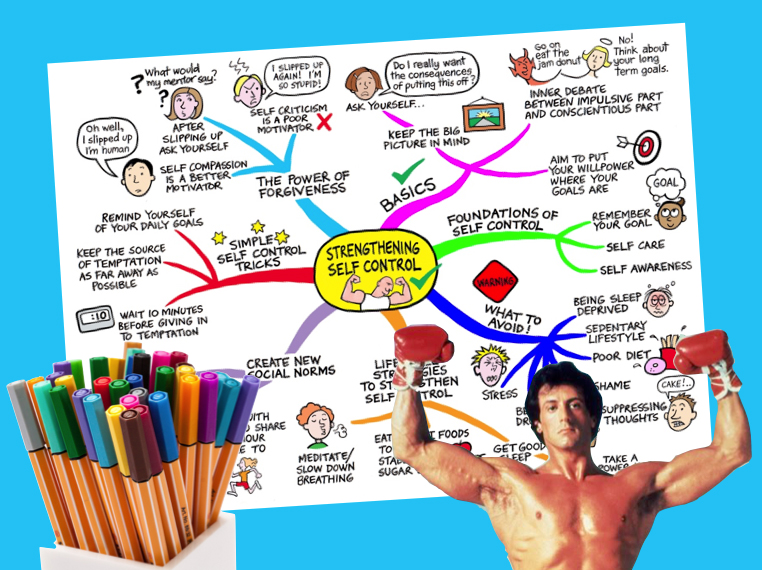
The funny drawings, the colour, and creativity can transform any dry subject into something that’s interesting for the brain.
But mind mapping is also a great life strategy. You can use it to create plans, capture ideas from books, set goals, clarify your thinking, organise your finances, and work your way out of messy situations.
Below I explore some different ways you can use mind maps in your day-to-day life.

Do you ever read books and then feel frustrated when you can’t remember much from them?
This is why I mind map out every non-fiction book that I read.
I know that there are limits to my memory. If I want to be able to extract ideas and strategies from a book and apply them to my life, I’m going to need to create mind maps.
There are two ways you can mind map a book:
1) You can mind map as you read: this forces you to slow down and really think about the ideas. I highly recommended doing this if the content is really complex. But this approach can be slow going!
2) You can mind map once you’ve finished reading: I use mini post-it notes to tab key ideas as I read. Once I’ve finished reading the book, I go back and mind map out the tabbed ideas. This way I have some perspective and can identify what’s important and what’s not (rather than assuming every sentence is important and needs to be mind mapped).
After I’ve finished mind mapping the book, I select a strategy that I’ve captured on the mind map to test out.
My husband has always been amazed at how I can take ideas from books and apply them to my life. But there’s no magic to this. I’m able to use lots of different strategies because mind mapping helps me to understand and remember them.
Let’s face it, if you can’t remember a strategy, you can’t use it!

Let’s say you have a test or exam coming up. Here’s how you can use mind maps to effectively prepare . . .
Push your notes and books to the side (you can’t look at them). Now grab a blank sheet of paper. Set a timer for 5 minutes and try to create a mind map on the main ideas you can remember.
Don’t try to make these mind maps look pretty. You’ve only got 5 minutes, so scribble and draw out as much as you can remember.
Once you’ve exhausted your memory, pull out your notes and pick a different coloured pen. Take a look at your messy mind map: What did you get right? What did you get wrong? Where are the gaps in your knowledge?
This strategy is called Active Recall and it’s the most effective way to retain information. You can read more about it here.
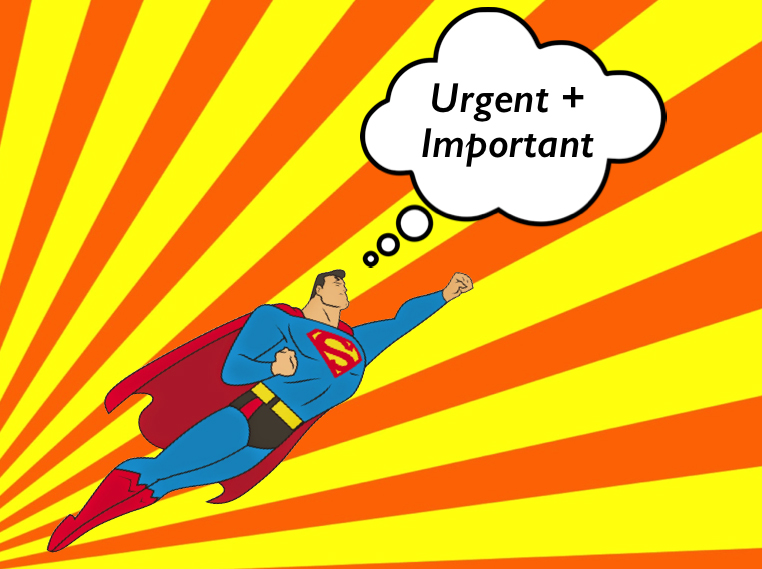
When you feel overwhelmed by life, everything can feel urgent and important. But not everything is urgent and important. A little prioritisation can save you a lot of stress and drama.
Grab a big sheet of paper, draw a circle in the middle, and write inside it Stuff to do. Now get everything out of your head and on to the page!
Once you’ve finished your mind map, look over all the tasks.
If a task is important, give it a tick.
If a task is urgent, circle it.
Focus your energy on knocking off the tasks that have ticks and circles around them (they are urgent and important).
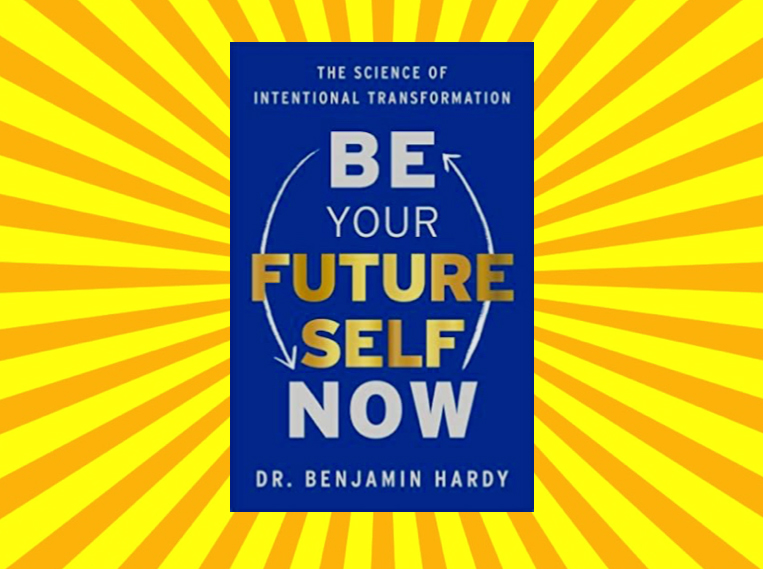
Research shows the more connected you are to your Future Self, the more committed you will be to achieving your goals and the wiser decisions you will make in the present.
Draw a circle in the middle of page and write inside it My Future Self. You can create branches for your Future Self in:
• 3 months’ time
• 6 months’ time
• 1 year’s time
• 3 years’ time
• 5 years’ time
Then off each of these main branches, write down your goals. What do you want to have accomplished by this time?
As Dr Benjamin Hardy states in his book Be Your Future Self Now:
“The clearer you are on where you want to go, the less distracted you’ll be by endless options.”
Note: Imagining your Future Self is not an easy thing to do. We are terrible at imagining where we are going to be in the future. So, don’t overthink it. Just get some ideas down on paper. As you gain more clarity around your goals and values, you can always add extra branches to your mind map.
I’ve found mind mapping to be a fun and effective way to capture, organise, and retain information. Even if I never look at the mind map again, the process of getting ideas down on paper makes a big difference. It helps me to feel more in control and on top of things.
If you need some clarity in a particular area, stop ruminating. Pick up a pen and start mind mapping!
Dr Jane Genovese delivers interactive sessions on learning to learn, combating procrastination, exam preparation, how to focus in the age of distraction, habit formation and much, much more!
Get FREE study and life strategies by signing up to our newsletter:
© 2024 Learning Fundamentals